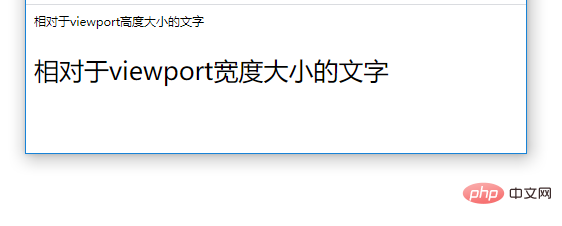What is the difference between vw and vh in css
The difference between vw and vh in CSS: the vw unit can automatically change the size according to the width of the window, "1vw" is "1%" of the window width; the vh unit can automatically change the size according to the height of the window, " 1vh" is "1%" of the window height.

The operating environment of this tutorial: Windows 10 system, CSS3&&HTML5 version, Dell G3 computer.
#What is the difference between vw and vh in css
In css, the difference between vw and vh is:
The vw unit can automatically change the size according to the width of the window, 1vw is 1% of the window width;
The vh unit can automatically change the size according to the height of the window, 1vh is 1% of the window height;
vw is an attribute of css, similar to px, rem, etc., and belongs to the length unit. In the browser, 1 vw = width of viewport/100
According to this feature, vw can help us implement mobile adaptive layout. Its advantage is that what you see is what you get, even better than rem, because it is not used at all. Use additional calculations.
It is recommended to use it with CSS preprocessing languages such as sass and less, because it can define variables and functions, which will provide great help in using vw.
vm, vh, vmin, vmax are window units and relative units. It is not relative to the parent node or the root node of the page. It is determined by the size of the viewport. The unit is 1, which means something like 1%. The viewport is the area of your browser that actually displays content—in other words, your web browser without toolbars and buttons.
The specific description is as follows:
vw: The percentage of the window width (1vw means the width of the window is 1%)
vh: The percentage of the window height
vmin: Take the smaller value of the current Vw and Vh
vmax: Take the larger value of the current Vw and Vh
The sum of the heights of vh and vw relative to the viewport Width, 1vh is equal to 1/100 of the viewport height, 1vw is equal to 1/100 of the viewport width. For example: browser height is 900px, width is 750px, 1 vh = 900px/100 = 9 px, 1vw = 750px/100 = 7.5 px , it is easy to realize a box with the same height as the screen.
The example is as follows:
<!DOCTYPE html>
<html lang="zh-cn">
<head>
<meta charset="utf-8" />
<title>vh_CSS参考手册_web前端开发参考手册系列</title>
<style>
.p1{font-size:5vh;}
.p2{font-size:5vw;}
</style>
</head>
<body>
<p class="p1">相对于viewport高度大小的文字</p>
<p class="p2">相对于viewport宽度大小的文字</p>
</body>
</html>Output result:

(Learning video sharing: css video tutorial)
The above is the detailed content of What is the difference between vw and vh in css. For more information, please follow other related articles on the PHP Chinese website!

Hot AI Tools

Undresser.AI Undress
AI-powered app for creating realistic nude photos

AI Clothes Remover
Online AI tool for removing clothes from photos.

Undress AI Tool
Undress images for free

Clothoff.io
AI clothes remover

Video Face Swap
Swap faces in any video effortlessly with our completely free AI face swap tool!

Hot Article

Hot Tools

Notepad++7.3.1
Easy-to-use and free code editor

SublimeText3 Chinese version
Chinese version, very easy to use

Zend Studio 13.0.1
Powerful PHP integrated development environment

Dreamweaver CS6
Visual web development tools

SublimeText3 Mac version
God-level code editing software (SublimeText3)

Hot Topics
 1387
1387
 52
52
 How to use bootstrap in vue
Apr 07, 2025 pm 11:33 PM
How to use bootstrap in vue
Apr 07, 2025 pm 11:33 PM
Using Bootstrap in Vue.js is divided into five steps: Install Bootstrap. Import Bootstrap in main.js. Use the Bootstrap component directly in the template. Optional: Custom style. Optional: Use plug-ins.
 The Roles of HTML, CSS, and JavaScript: Core Responsibilities
Apr 08, 2025 pm 07:05 PM
The Roles of HTML, CSS, and JavaScript: Core Responsibilities
Apr 08, 2025 pm 07:05 PM
HTML defines the web structure, CSS is responsible for style and layout, and JavaScript gives dynamic interaction. The three perform their duties in web development and jointly build a colorful website.
 How to write split lines on bootstrap
Apr 07, 2025 pm 03:12 PM
How to write split lines on bootstrap
Apr 07, 2025 pm 03:12 PM
There are two ways to create a Bootstrap split line: using the tag, which creates a horizontal split line. Use the CSS border property to create custom style split lines.
 Understanding HTML, CSS, and JavaScript: A Beginner's Guide
Apr 12, 2025 am 12:02 AM
Understanding HTML, CSS, and JavaScript: A Beginner's Guide
Apr 12, 2025 am 12:02 AM
WebdevelopmentreliesonHTML,CSS,andJavaScript:1)HTMLstructurescontent,2)CSSstylesit,and3)JavaScriptaddsinteractivity,formingthebasisofmodernwebexperiences.
 How to resize bootstrap
Apr 07, 2025 pm 03:18 PM
How to resize bootstrap
Apr 07, 2025 pm 03:18 PM
To adjust the size of elements in Bootstrap, you can use the dimension class, which includes: adjusting width: .col-, .w-, .mw-adjust height: .h-, .min-h-, .max-h-
 How to use bootstrap button
Apr 07, 2025 pm 03:09 PM
How to use bootstrap button
Apr 07, 2025 pm 03:09 PM
How to use the Bootstrap button? Introduce Bootstrap CSS to create button elements and add Bootstrap button class to add button text
 How to set up the framework for bootstrap
Apr 07, 2025 pm 03:27 PM
How to set up the framework for bootstrap
Apr 07, 2025 pm 03:27 PM
To set up the Bootstrap framework, you need to follow these steps: 1. Reference the Bootstrap file via CDN; 2. Download and host the file on your own server; 3. Include the Bootstrap file in HTML; 4. Compile Sass/Less as needed; 5. Import a custom file (optional). Once setup is complete, you can use Bootstrap's grid systems, components, and styles to create responsive websites and applications.
 How to insert pictures on bootstrap
Apr 07, 2025 pm 03:30 PM
How to insert pictures on bootstrap
Apr 07, 2025 pm 03:30 PM
There are several ways to insert images in Bootstrap: insert images directly, using the HTML img tag. With the Bootstrap image component, you can provide responsive images and more styles. Set the image size, use the img-fluid class to make the image adaptable. Set the border, using the img-bordered class. Set the rounded corners and use the img-rounded class. Set the shadow, use the shadow class. Resize and position the image, using CSS style. Using the background image, use the background-image CSS property.




